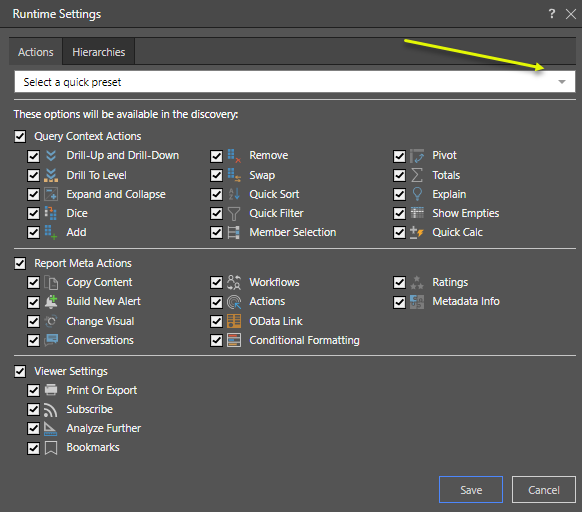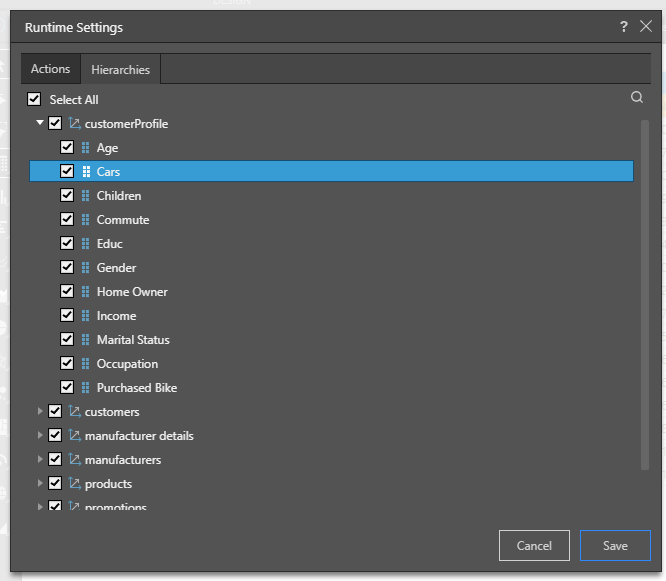Runtime Settings determine which functions and actions will be available when using the context menu on the Discover report - and it also includes an ability to customize which hierarchies are shown to users in the Dice, Add and Swap context menus.
This is useful if there are actions and hierarchies that you want to disable due to privacy or governance, or to enhance the user experience for report viewers. For example, you may want to disable drill functions to stop users from drilling down into the data.
When a user configures runtime settings, those settings are applied to the report for all users. However, any other users with write permissions to the report have the ability to change the runtime settings.
- These settings are similar to the settings in Present.
Open Runtime Settings Dialog
Open the Runtime Settings dialog from the Design ribbon:

The Runtime Settings are split across two tabs:
- Actions, which controls all the functionality exposed to end users consuming the dashboard.
- Hierarchies, which controls the model hierarchies that are visible to end users in the Dice, Add, and Swap menus.

Actions tab
You can either select one of three presets (yellow arrow above) or manually enable and disable the required functions individually. The preset options are:
- Full Selection: enables all runtime settings; you can disable required settings by clearing the checkboxes.
- Light Selection: enables only drill, dice, quick sort, quick filter, pivot, and conversations; you can disable any of these or enable additional functions.
- Nothing Selected: disables all runtime settings; you can enable required settings by selecting their checkboxes.
Query Context Actions
Enable or disable runtime functions that affect the query context:
- Drill-Up and Drill-Down: drill up or down to the next level of the hierarchy.
- Drill to Level: drill to a specified level of the hierarchy.
- Expand and Collapse: expand lower levels of the hierarchy.
- Dice, Add, Remove, and Swap: drill across to another hierarchy, inject another hierarchy into the query, remove a hierarchy, or replace a hierarchy with a different one.
- Quick Sort: apply quick sorts from the context menu.
- Quick Filter: apply quick filters from the context menu.
- Member Selection: select a member to drill into it, expand it, dice, or focus or eliminate.
- Pivot: switch the discovery's x- and y-axes.
- Totals: add totals columns and rows to grids.
- Explain: use machine learning to provide insights into the data.
- Show Empties: show empty data cells.
- Quick Calc: design quick calculations on the fly and add them to the query.
Report Meta Actions
Enable or disable runtime functions that affect the report:
- Copy Content: copy the raw data from the discovery.
- Build New Alert: create automated alters based on a given value in the discovery.
- Change Visual: change the type of graph used to display the data.
- Conversations: start, or participate in, conversation threads based on the discovery.
- Workflows: start, or participate in, workflow or conversation threads based on the discovery.
- Actions: enable users to launch actions that have been configured for the discovery.
- OData: copy a URL or snippet to your clipboard that allows results to be read into another client's technology.
- Conditional Formatting: add extra information to charts to highlight important features.
- Ratings: rate a content item, on a scale of 1 to 5.
- Metadata Info: enable or disable users to view metadata info.
Viewer Settings
Enable or disable functions for users with a viewer license:
- Print or Export: allow viewer users to print or export the data discovery.
- Subscribe: enables users to subscribe to presentations.
- Analyze Further: opens the selected data discovery in Discover Lite, where the user can perform further analysis and save a new version of the discovery.
- Bookmarks: enable or disable users from creating and accessing bookmarks.
Hierarchies
You can "slim down" very large data models as they appear in the Dice, Add, and Swap menus for end users by adjusting your hierarchies.
